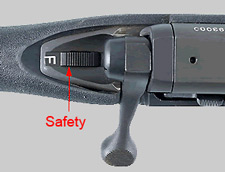- 01: Introduction
- 02: History
- 03: Propellants, Firearms, and Ammunition Development
- 04: Modern Firearms Manufacture
- 05: Small Arms Ammunition
- 06: Evidence Handling Procedures
- 07: Equipment and Instrumentation
- 08: Examination of Firearms
- 09: Cartridge and Shotshell Examination
- 10: Characterization and Evaluation of Fired Projectiles
- 11: Bullet Comparison and Identification
- 12: Gunshot Residue and Distance Determination
- 13: Toolmark Identification
- 14: Communicating Results
- Resources


Long Guns
Home > Examination of Firearms > Examination > Safety Features > Long Guns

Most long guns contain an external safety device. Magazine-fed long guns (box or tube) may also have a disconnector. Some shotguns, normally the top-break multibarrel type, may have an automatic safety. These are designed to engage the safety when the breech is unlocked for loading and unloading.
The results of the following steps in the examination of the safety features of long guns should be documented.
- Check for an external safety device; this should be clearly marked in most long guns.
- Confirm that the firearm is empty.
- Function the action and cock the firearm.
- Place the safety in the safe position.
- Pull the trigger.
If functioning properly, the safety should block the trigger from operating. If the safety is functioning improperly, the following test should be performed.
- Confirm that the long gun is empty.
- Place a primed cartridge case in the chamber.
- Function the action and cock the firearm.
- Place the safety in the safe position.
- Pull the trigger.
If the primed case detonates, the safety is not functioning properly.
To test the disconnector, the results of the following steps should be documented.
- Confirm that the long gun is empty.
- Function the action and cock the firearm.
- Ensure that the external safety is disengaged.
- Pull the trigger and hold it to the rear while cocking the firearm.
(The hammer or striker should not fall; the trigger should move forward and reset.) - Cock the firearm again.
- Disengage the external safety.
- Open the action far enough to take it out of battery.
- Pull the trigger.
The firearm should not fire. If the long gun fails either the external safety or the disconnector test, it may still function, but not as designed.




